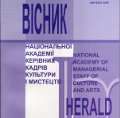СПЕЦИФІКА ІНТЕРПРЕТАЦІЙ КОМПОЗИЦІЙ У НАТЮРМОРТІ
Specificity of Interpretation of Compositions in Still Life
Author(s): Julii SkakandiySubject(s): Visual Arts, Sociology of the arts, business, education, Sociology of Art, History of Art
Published by: Національна академія керівних кадрів культури і мистецтв
Keywords: Watercolor; still life composition; natural settings; plein air; colour relationships; lighting;
Summary/Abstract: The purpose of the study isto reveal the peculiarities of interpretations of compositions in still life using the example of five productions and to illustrate them with exemplary works. The research methodology is based on the application of methods of analysis, observation, description, which allow us to investigate the peculiarities of interpretations of the given compositions. The scientific novelty lies in the fact that the author has expanded and supplemented the features of work on such an important area of watercolor painting as still life. The implementation of the set tasks is clearly demonstrated on the examples of specific productions. Conclusions. An important achievement of the research is that, like a portrait and a landscape, a still life has its own special means of influencing the mood and thoughts of the audience. Of course, a person, his/her complex spiritual world, the most diverse images of nature open up wider opportunities for the painter to interest and affect the viewer than images of "dead things". Thus, still life enables verifying that in painting not only the object of the image, but also the way it is depicted determines the content of the work. By combining various methods of work and looking for the new ones, the artist can achieve in his/her works such strength and expressiveness, juiciness and brightness of colour, the most subtle transitions of tone, depth, and various textures, which will raise his/her creativity to a qualitatively higher level. The creative principle in the work always prevails and is combined with the experiment, as well as with the emotionality of the artist, his/her ability to generalise and select, to think plastically, with visual memory. A mature artist relies on these qualities already purely mechanically, but knowledge of the basic laws of painting, drawing, and composition are always present in his/her mind, thereby forming his/her system of methods. Therefore, the main task of a young artist is to master the techniques of the craft, to master the basic laws, that is, to lay a solid foundation for the development of one's own thoughts, creative ideas, the power of expression of which will be determined, without a doubt, by the artist's talent.
Journal: Вісник Національної академії керівних кадрів культури і мистецтв
- Issue Year: 2023
- Issue No: 1
- Page Range: 180-184
- Page Count: 5
- Language: Ukrainian

